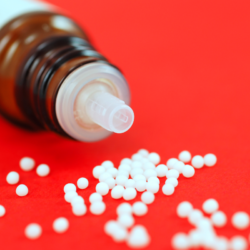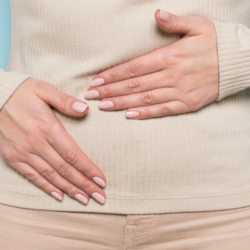Acetonemic vomiting in children is a condition also known as “periodic ketosis”, because the vomiting is contingent. Hyperketonemia is the consequence of a transient disturbance in lipid metabolism when there is a momentary lack of glucose availability following insufficient intake or excessive expenditure of carbohydrates:
- Diet deviations (fat abuse, simple fasting, carbohydrate fasting, diabetes)
- Febrile reaction to an infectious or inflammatory process
- Intestinal parasitosis
- Excessive physical effort
- Tiring travel, change of climate or altitude
- Asthma, neurological or endocrine diseases
- Emotions or upset
What is hepatic ketogenesis?
Hepatic ketogenesis, which is the normal function of acetyl coenzyme A, becomes too important. Acetylacetic acid, β-hydrobutyric acid and acetone accumulate in the blood, with ketone levels reaching several grams per litre (physiological level: 15 to 20 mg per litre). They are eliminated in the urine, although ketonuria does not necessarily follow ketonemia. In this article, we will only consider the homeopathic treatment of the simple crisis of acetonemic vomiting and we will eliminate from the question the diseases in which the exaggeration of ketogenesis is only one side of the problem: diabetes, hyperthyroidism…
Clinically, vomiting , which is variable in amount but often contains bile, is accompanied by abdominal pain, moderate metabolic fever, depression, a certain pallor with dark circles around the eyelids and an aromatic smell on the breath reminiscent of apples. The diagnosis of hyperketonemia is confirmed by the presence of ketone bodies in the urine, as indicated by a coloured indicator.
Acetonaemic vomiting occurs mainly in fits and starts, most often in children who have not reached puberty, with a particular background: thin, tired and emotional individuals with a fickle appetite, attracted by salty or spicy foods, cold meats and cheeses, disdaining sweets with the exception of chocolate, often prone to verminosis, and the offspring of parents with migraine or dyspepsia. This condition is rarely seen in North America due to dietary habits. Homeopathic treatment of the attack must be accompanied by a medical prescription.
The main homeopathic medicines
Several home opathic strains can be used in the homeopathic treatment of acetonic vomiting in children. These strains have specific properties that help to relieve symptoms and restore balance in the body. In this section, we will look at the main homeopathic medicines used to treat acetonaemic vomiting in children, their properties and recommended dosages. It is important to note that every child is unique and that homeopathic medicines should be prescribed according to individual symptoms and medical history. It is advisable to consult a homeopathic healthcare professional for personalised advice on the choice of homeopathic medicines for the treatment of acetonaemic vomiting in children.
Senna :
The remedy senna is the main drug because it experimentally causes digestive disorders perfectly similar to those observed during acetonaemia crisis :
- Aromatic odour of the breath
- Nausea, vomiting, colic and flatulence
- Rapid exhaustion and paleness of the face
The homeopathic remedy Senna, in addition to its main role in treating the digestive disorders associated with acetonaemia, offers a comprehensive approach to managing this condition. In homeopathy, its effectiveness is recognised thanks to its ability to treat symptoms that closely mirror those of the acetonaemia crisis, such as the aromatic smell of breath, nausea, vomiting, colic and flatulence. In addition, its relevance is highlighted in cases of rapid exhaustion accompanied by paleness of the face.
Dosage: It should be taken almost systematically, in 5 CH, in repeated doses of 5 granules every half hour or every hour, depending on the severity of the case.
It may be taken alternately with one or more of the following medicines, depending on the patient’s reaction:
Lycopodium clavatum :
Generally used as a background medication in this type of condition, Lycopodium is used as an acute crisis medication in thin, yellowish-skinned patients, usually presenting with borborygma and intestinal flatulence which is often painful and aggravated by starchy foods, eggs and chocolate. Patients treated with the drug are often also nervous, prone to eczema and frequently present with breech dermatitis before cleanliness has been acquired.
Dosage: take 5, 7 or 9 CH, 5 granules, 2 to 3 times a day.
Phosphorus :
Food vomiting is abundant and burning for the mouth and oesophagus. It often contains bile. There is a moderate fever, sweating and prostration. The thirst for cold water is very strong, but drinks are quickly rejected. The tongue is dry and red.
Posology: Take 9 CH, 5 granules alternating with Senna.
When can Phosphorus homeopathic remedy be used?
The homeopathic remedy Phosphorus is used to treat a variety of health problems in homeopathic practice. Here are some of its main applications:
- Respiratory Problems: Phosphorus is often recommended to treat respiratory problems such as bronchitis, pneumonia, and asthma. It is particularly useful when these conditions are accompanied by a dry, painful cough.
- Digestive disorders: This remedy can also be effective for certain digestive disorders, such as vomiting, heartburn and gastric ulcers. It is often chosen for people who experience a burning sensation in the stomach.
- Bleeding: Phosphorus is recognised for its ability to help control bleeding, whether nasal, gastrointestinal, or even linked to gynaecological problems.
- Nervous problems: It is also used to treat certain nervous disorders, including anxiety, fatigue and sleep disorders, particularly in people who are sensitive, emotional and outgoing.
- Effects on Mood: Phosphorus can be beneficial for people suffering from depressive symptoms, particularly when they feel indifferent towards things that used to interest them.
- Bone health: This remedy can also be used to treat certain bone problems, such as osteoporosis or slow healing of fractures.
Ipecac :
This remedy is used in cases of profuse vomiting with a clean or slightly loaded tongue, hypersialorrhoea and lack of thirst.
Dosage: Take in doses of 5 x 7 or 9 CH granules, as and when vomiting occurs.
When should I take Ipeca granules?
The homeopathic remedy Ipeca, also known as Ipecacuanha, is used in several contexts in homeopathy. Its main applications are as follows:
- Respiratory disorders: Ipeca is frequently prescribed to treat respiratory problems such as bronchitis, asthma and whooping cough. It is particularly effective in cases of wet cough with abundant phlegm.
- Nausea and vomiting: This remedy is well known for its effectiveness in treating nausea and vomiting, especially when they are persistent and accompanied by excessive salivation and a clean (not loaded) tongue.
- Bleeding: Ipeca can also be used to manage certain types of bleeding, such as uterine bleeding or nosebleeds, especially when associated with nausea.
- Gastroenteritis: It is indicated in cases of gastroenteritis, particularly when symptoms include nausea, vomiting and diarrhoea.
- Fever and febrile states: Ipeca is also used in the treatment of febrile states, particularly when accompanied by chills, sweating and difficult breathing.
Antimonium crudum :
Antimonium crudum homeopathic granules are used in a variety of contexts in homeopathy. Here are some of their main indications
What are the indications for Antimonium crudum homeopathic granules?
- Digestive disorders: Antimonium crudum is often prescribed to treat digestive disorders, particularly indigestion, bloating and nausea. It is particularly indicated when these symptoms are accompanied by a thick, white tongue.
- Skin problems: This remedy can be effective in treating certain skin conditions, such as eczema, warts and rashes. It is often chosen for rashes that are pustular or worsen with heat and humidity.
- Emotional and Behavioural Conditions: Antimonium crudum is also used to treat certain emotional conditions, including irritability, sulking, and a tendency to be easily upset or offended.
- ENT problems: It may be indicated for hoarseness and coughs, particularly when the cough is aggravated by heat or overeating.
- Gastrointestinal disorders in children: This remedy is sometimes used to treat gastrointestinal disorders in children, particularly when these disorders are associated with overeating or excessive consumption of sweets.
This medicine is taken in cases of profuse vomiting of food, with a chalk-white coating on the tongue and intense thirst, especially for acidic or fizzy drinks. This picture is most often seen in acetonaemic vomiting following overeating.
Dosage: Take 5 CH 7 or 9 granules at the same time as vomiting.
Some naturopathic dietary advice
In the natural treatment of acetonaemic vomiting in children, dietetics plays an essential role in restoring balance to the body. As the condition leads to glucose deficiency and loss of water and electrolytes, it is important to provide the patient with sufficient water, carbohydrates and electrolytes to maintain good hydration and prevent complications.
To achieve this, it is advisable to give plenty of sugary drinks, such as herbal teas, fresh fruit juices, lemonades and soft drinks, as well as salted vegetable broths to provide electrolytes, particularly sodium chloride to combat hypochloremia. It is important to give these drinks in small, frequently repeated quantities, according to the patient’s wishes and tolerance.
It is also advisable to eliminate fats and proteins from the diet, including dairy products, until the ketonuria disappears, which can be monitored with a coloured indicator. Solid foods should include bread, pasta, potatoes, rice, carrots, water-based flours, compotes and jams. It is important to take into account the child’s food preferences and to respect their digestive tolerance to ensure adequate nutrition.
In summary, diet is an important element in the natural treatment of acetonaemic vomiting in children. It is essential to provide sufficient water, carbohydrates and electrolytes to maintain good hydration and prevent complications. Sugary drinks and salty vegetable broths should be given, while avoiding fats and proteins, until the ketonuria disappears. Solid food should consist of easily digestible foods such as bread, pasta, potatoes, carrots, water-based flours, compotes and jams.
There is a glucose deficiency and a loss of water and electrolytes. The patient must therefore be given plenty of:
- Water
- Carbohydrates
- Electrolytes (sodium chloride, especially to combat hypochloremia)
We recommend plenty of sweet drinks (herbal teas, fresh fruit juices, lemonades, soft drinks) and salty vegetable broths. These should be taken cold, warm or hot, in small, frequently repeated quantities, according to the patient’s wishes and tolerance. It is also essential to eliminate fats and proteins from the diet, including dairy products, until the ketonuria disappears, and to monitor this with a coloured indicator.
Until then, solid food should consist of bread, pasta, potatoes, rice, carrots, water-based flours, compotes and jams.







